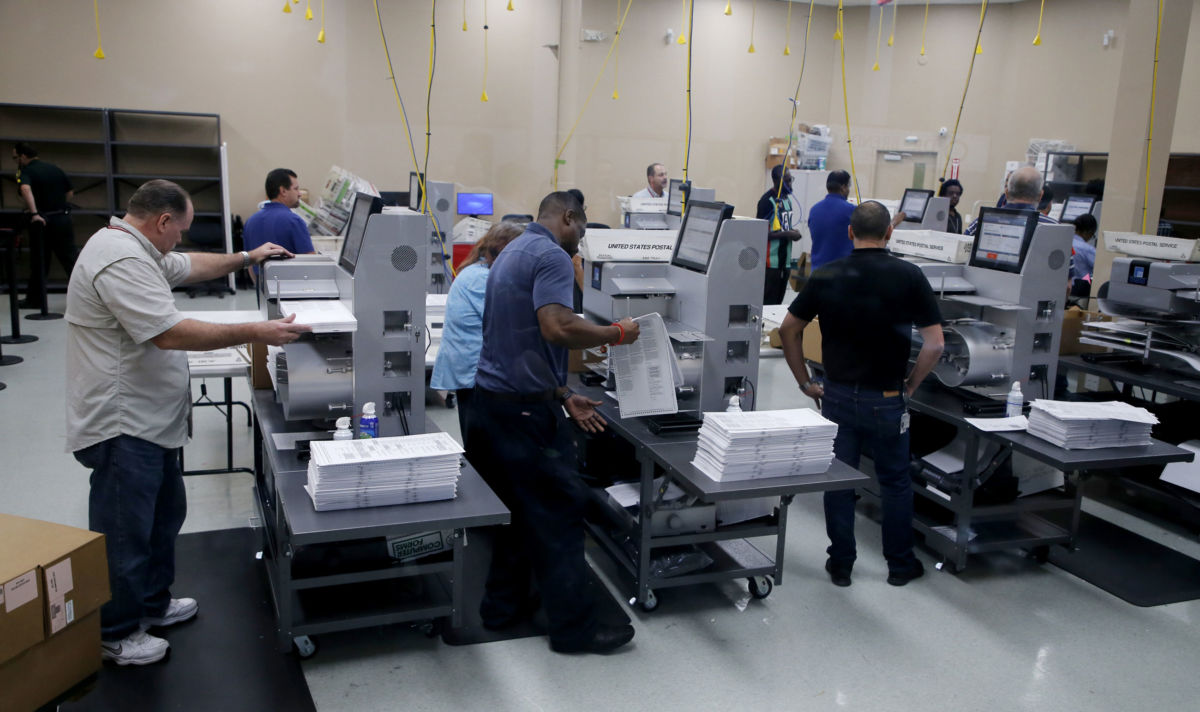Counties across Florida are currently under intense pressure and scrutiny as they race to complete the unprecedented task of three simultaneous statewide recounts. According to a schedule provided to Truthout by the Florida Fair Elections Coalition (FFEC), the deadline for finishing machine recounts and submitting those second unofficial results is Thursday, November 15, at 3 pm. Races that are close enough to require what is being described as a “manual” recount — where a limited number of ballots are counted by hand — must submit official returns Friday, November 16, by noon. Palm Beach County Supervisor of Elections Susan Bucher has already stated that her county will be unable to meet the deadline, calling it “impossible.” The statewide races where recounts are required are for governor, agricultural commissioner and Senate, where current Gov. Rick Scott maintains a razor-thin lead of 12,562 votes in his attempt to take a Senate seat away from his rival Democrat incumbent Sen. Bill Nelson. That lead is now less than the mysterious 25,000 undervote that was reported previously in the race.
According to The New York Times, if any county cannot complete the recount by the deadline, then Saturday’s results will stand in that county. Another county that is likely to find the recounts challenging is Broward County, a behemoth Democratic stronghold with over 700,000 total ballots cast. The supervisor of elections there, Brenda Snipes, received a summary judgment against her in May 2018 for illegally destroying ballots in the 2016 Democratic congressional primary race between incumbent Congresswoman Debbie Wasserman Schultz and Tim Canova, a professor of law and public finance at Nova Southeastern University.
The destruction of those ballots has received considerable attention lately. Governor Scott cited it in his emotionally charged press conference Thursday as one reason for filing a lawsuit against the county. The court action — which he won — demanded an emergency hearing and the right to inspect all of the county’s ballots. On Friday, Florida Congressman and Trump bullhorn Matt Gaetz was yelling at the top of his lungs, “Remember, Brenda Snipes destroyed ballots in 2016! Who the hell destroys ballots?” as protesters chanted, “Snipes is corrupt!” outside the Broward County Supervisor of Elections Office. President Trump lost no time jumping into the fray, tweeting that same day about the “Broward Effect” and asking why they never find Republican votes.
Rick Scott was up by 50,000+ votes on Election Day, now they “found” many votes and he is only up 15,000 votes. “The Broward Effect.” How come they never find Republican votes?
— Donald J. Trump (@realDonaldTrump) November 9, 2018
But it’s not just Republicans who are fed up with Snipes’s performance as the Broward County supervisor of elections. Kitty Garber, the research director and co-founder of the nonpartisan FFEC expressed similar concerns, saying Snipes “has presided over a continuous sequence of election disasters.”
Rick Scott, as governor, was the one person who could have removed Snipes from office following the judgment against her. Previous governors have removed elected officials from office when they were found engaging in misconduct, and Garber wonders why the governor didn’t do something about Snipes when he had the opportunity. She offered a different perspective on his motivation.
“It is Rick Scott’s administration that has ignored the calls for Snipes to be removed or reprimanded for her behavior. Why is that? Because her behavior has disproportionately harmed Democratic candidates,” Garber told Truthout in an email. “When absentee ballots go missing in largely Democratic Broward County, you can be sure that most of them belong to Democratic voters.”
Canova, who lost his race in the election where Snipes destroyed the ballots, condemned the entire process as undemocratic. He posted a video tweet, saying, “I know at the heart of your anger is what I felt after no one stepped up to investigate Brenda Snipes — it’s losing confidence we have in democracy.”
Programmable Results
After his 2016 encounter with Brenda Snipes and the Broward County Supervisor of Elections office, Canova’s frustration was deep enough to propel him to leave the Democratic Party, although not enough to give up politics. He is running for Congress again in the 23rd District, this time as an Independent. Wasserman Schultz is again his main rival, but it is a four-way race that also includes Republican Joe Kaufman and Independent Don Endriss. Wasserman Schultz has already declared victory, with current results showing her at close to 59 percent. But Canova has refused to concede. His mantra has been that in Florida, both parties are locked in a culture of corporate corruption. Although his second campaign did not generate the millions in small donations that his first run did, it sparked a large influx of motivated, new voters and he decried the unofficial results that show him receiving 5.1 percent of the vote. In an email to a group of election security advocates and experts, he said, “After the bullshit results were announced…. What does that even mean … when insiders can program any result they want?”
Bennie Smith, a computer programmer who does demographic analysis for candidates in Memphis, Tennessee, said that the surging turnout among young and first-time voters in the early voting data he reviewed seemed to support Canova’s logic. He suggested that Canova might want to try collecting affidavits from voters, and see if there are more voters who say they voted for him in a given precinct than were reported.
Can election results be programmed by malware to report a different result than what the voters intended? Security experts have been warning for years that this was possible. In a 2017 congressional briefing, Alex Halderman, a professor of computer science at the University of Michigan, said, “Hacking a national election in the United States would be, well, shockingly easy.” He goes on to say, “Both of the DRE style and the optical scan style [voting] machines have been brought into the laboratory. And in every single case [they’ve] been shown to suffer from vulnerabilities that would allow the spread of vote-stealing malware.”
Smith was featured in a Bloomberg Businessweek report on election irregularities in his hometown of Memphis, Tennessee. He is an underground celebrity in the election security community for having developed a proof of concept program that assigns percentages to votes cast for different candidates so that the redistribution of votes seems plausible and corresponds to the voters who turned out.
In a phone interview with Truthout, he said a program like this “could happen at the machine to each single vote,” but emphasized that it would be more efficient to run the program on the central tabulation computer. He described it as a type of “bonus” option that the software is designed to accept but that only a few people might have access to, somewhat like upgrading from a free to a paid application that has extra features. “You build a system and you build a standalone component,” he said, adding that the “component is only in the hands of a select few people.”
Garber pointed out that the software management systems that Broward and many other Florida counties use are provided by VR Systems, a company that is widely believed to have been hacked in 2017, although the company has denied it.
A Vast Array of Irregularities in the 2018 Broward County Results
Truthout did a preliminary analysis of the data that is currently available in the November 6 general election in Broward County. We downloaded the data throughout the counting process to see how it was changing. We also compared some of the Broward County data to other counties. We found a vast array of irregularities in the Broward County results.
Our research is in the early stages. During the time we were collecting and analyzing data, the counties’ results were all still updating, so these figures are approximate and fluid. Where possible, we have gone back and tried to update with final data, but in light of the undergoing recount, we are releasing preliminary assessments as rapidly as possible.
Here are examples of irregularities and the data packets that we are releasing to illustrate them.
1) Time-stamped video of the completely reported results from the Broward County Supervisor of Elections website in the Senate race between Nelson and Scott, the governor’s race between Gillum and DeSantis and the 23rd Congressional District race show votes for candidates in precinct after precinct with totals and percentages listed, but no indication of where and how those votes were cast.
The categories of Election Day, Vote By Mail, Early Voting, Write-In and Provisional Votes are all frequently completely blank. Leaving all of these categories vacant would allow the totals for any candidate to be reallocated with ease. We found this pattern throughout the Broward County results, including the agricultural commissioner race, which is also undergoing a recount, and the race for attorney general.
Until the county updates the data, this can be confirmed by going to the Broward County Supervisor of Elections website. Click on “Election Information” on the left side of the page to reveal a dropdown menu. Select “Election Results,” and then “November 6, 2018 General Election.” On the tab, select “Precinct Results.” Set the “View Type” as “Detailed” and select the race you would like to view.
Election officials we consulted said that most state laws do not require jurisdictions to include information about the voting method, and that there are a lot of innocent explanations for that. But Douglas Jones, a professor of computer science at the University of Iowa, said that Broward County’s history “sets out a strong reason for being highly suspicious.” Other counties in Florida are reporting votes by category.
2) Screenshots showing the same issue listed above. A screenshot of our data shows that in precincts M006, M008, M010 and M011, Canova received 67 votes, but there is no indication of how. This is just one example of a problem that occurs throughout the results.
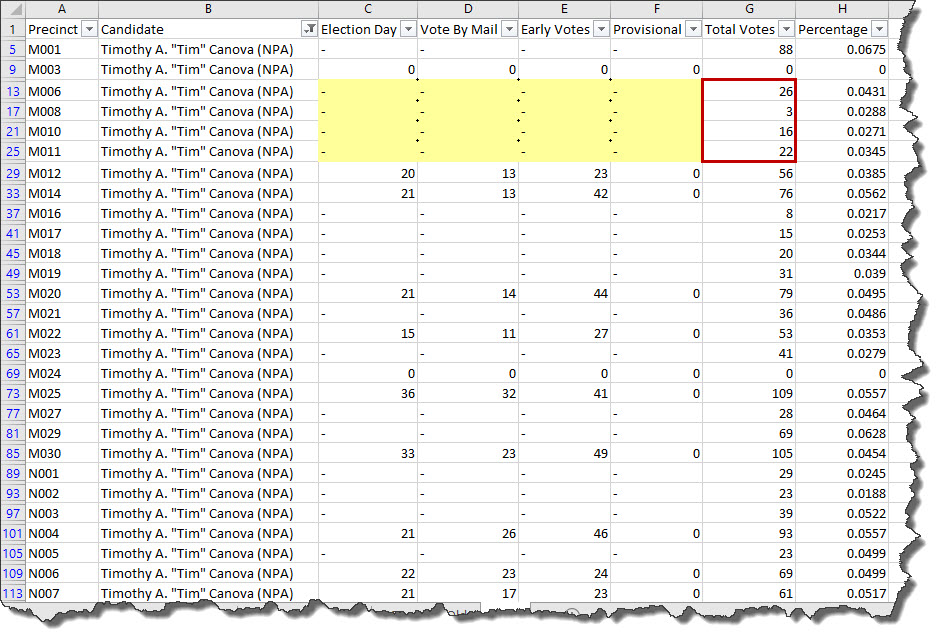
3) Spreadsheets of data downloaded from the Broward County Supervisor of Elections’ website show that data is being removed, not added. When we first downloaded the results of the 23rd Congressional District on November 8, there was more information in the various categories, such as Election Day, Vote By Mail and Early Voting. When we downloaded the information again on November 11, many more of the categories had become blank. This seems odd, since in general, counties are adding more information, or updating totals as they count the votes, not removing already reported results.
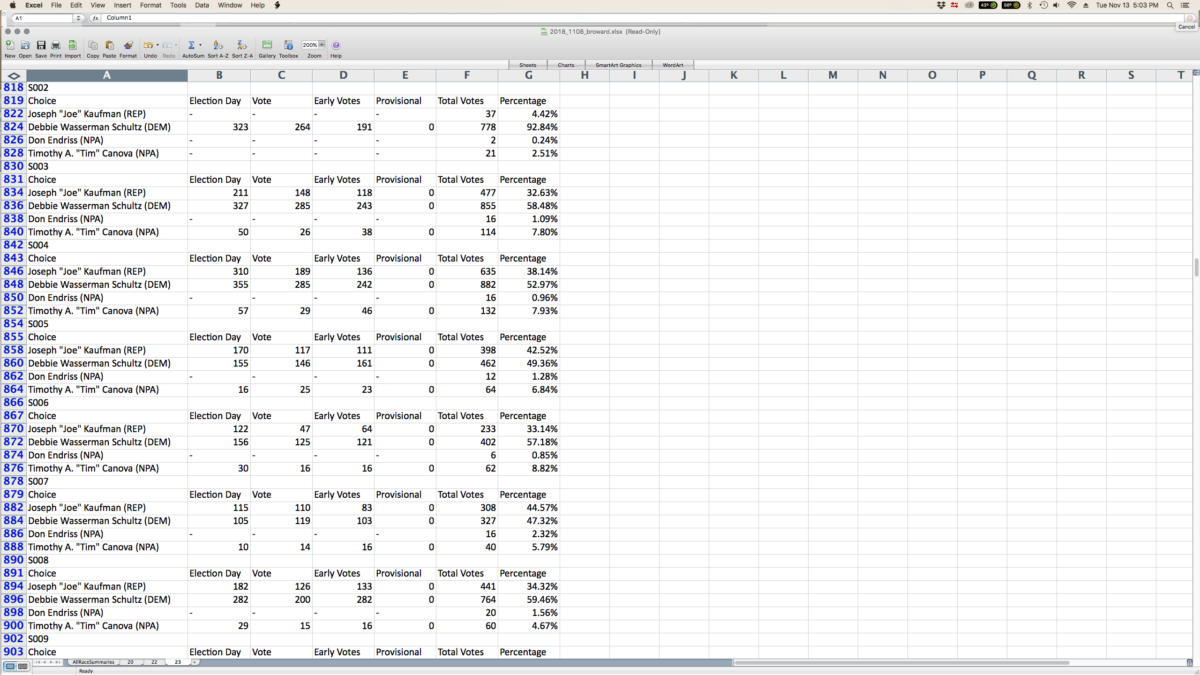
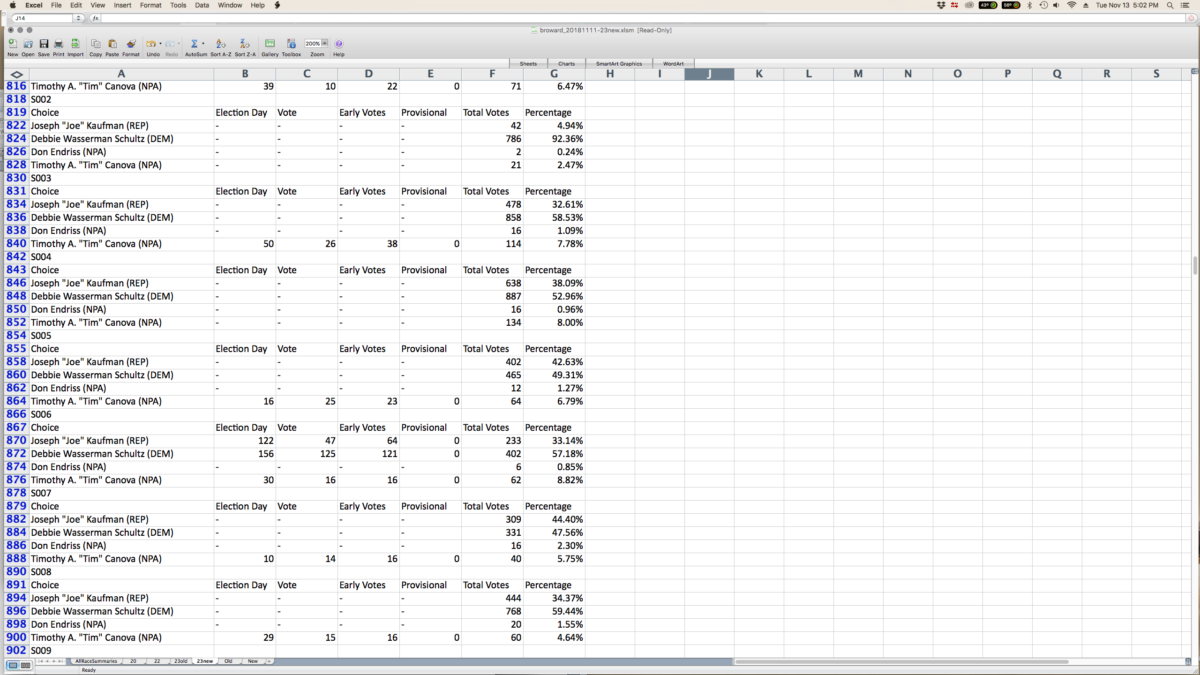
4) A spreadsheet showing that Wasserman Schultz received close to 100,000 votes in precincts with no indication how or when those votes were cast.
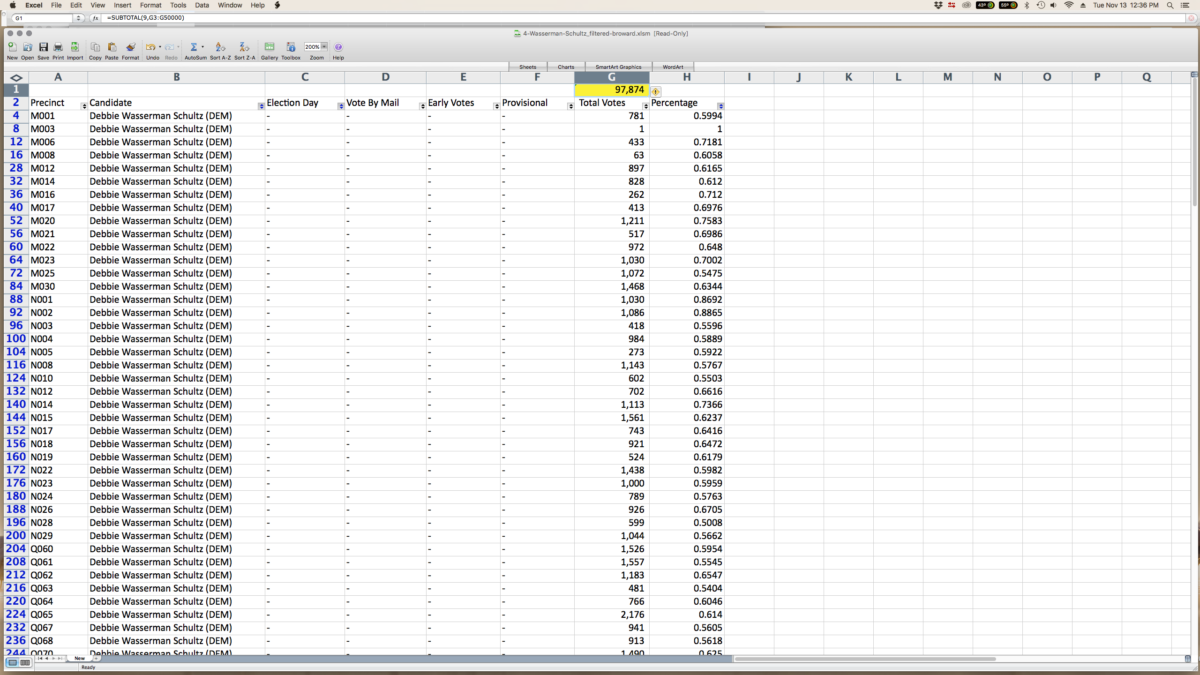
5) There appears to be an unusually high number of undervotes in the race for Congress in the 23rd District in Broward County — the race between Canova and Wasserman Schultz. An undervote is a ballot where a voter has signed in, and cast a ballot, but for some reason not voted in a given race.
A high undervote rate can be concerning, because it may mean that legitimate votes have either not been counted or have been discarded.
Truthout estimates the undervotes in the 23rd Congressional District race at around 11,000, or 4.4 percent, a figure that is approximately twice as much as the undervotes in any other congressional district race. A precinct by precinct analysis of the undervotes in the 23rd District race shows that in particular, there are four precincts (V012, V030, V010 and M008) with undervotes of between 63 and 90 percent.
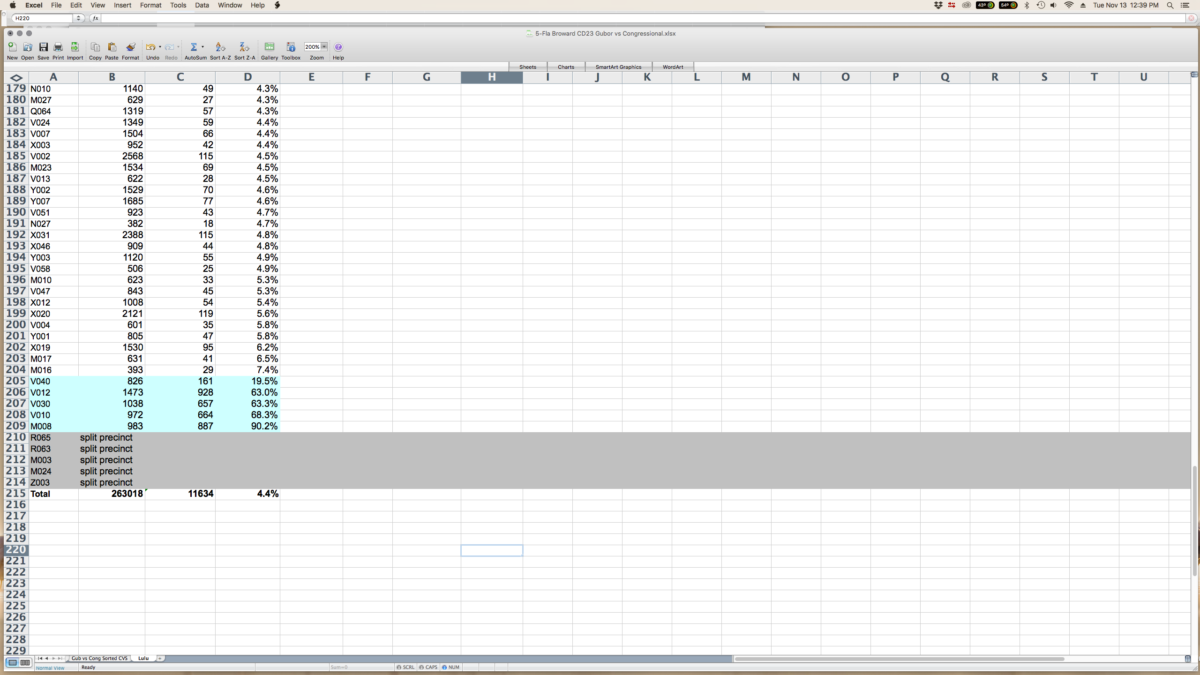
Undervotes in the Broward County 23rd District congressional race are challenging to calculate because Broward County includes four congressional districts, one of which (the 24th) did not have a race on the ballot. There are also precincts that are split between two districts. At first glance, it might appear that there are 70,000 undervotes in the district, but after taking into account those factors, we found an undervote rate that was still twice as high as any other district in the state. Over 10,000 voters appear not to have cast a vote in this race.
Other districts show a range in the number of voters who did not participate in their congressional races, from very small counties like Lafayette, where 67 voters out of 2,830 (2.3 percent) did not choose to cast a ballot for Congress, to larger counties like Volusia, where the number was close to 5,000 out of around 230,000 (2.2 percent). On average, the other Florida congressional districts have an undervote rate of 1.69 percent, based on the totals being reported at the time the data was collected. All of these numbers were fluctuating somewhat as the counties were finishing their preliminary count. But no other district that we examined approached the high percent of voters who appear not to have cast a vote in the Wasserman Schultz/Canova race.
We calculated the undervote for the congressional race by comparing that race to voters who voted in the governor’s race, because a total number of votes by precinct was unavailable at that time.
Poor Ballot Design Is Offered as One Explanation
One possibility offered to explain the large number of voters not participating in the Senate and congressional races was an unfortunate ballot design in Broward that had both races in the lower left hand corner, even though these are considered top-of-ticket races.
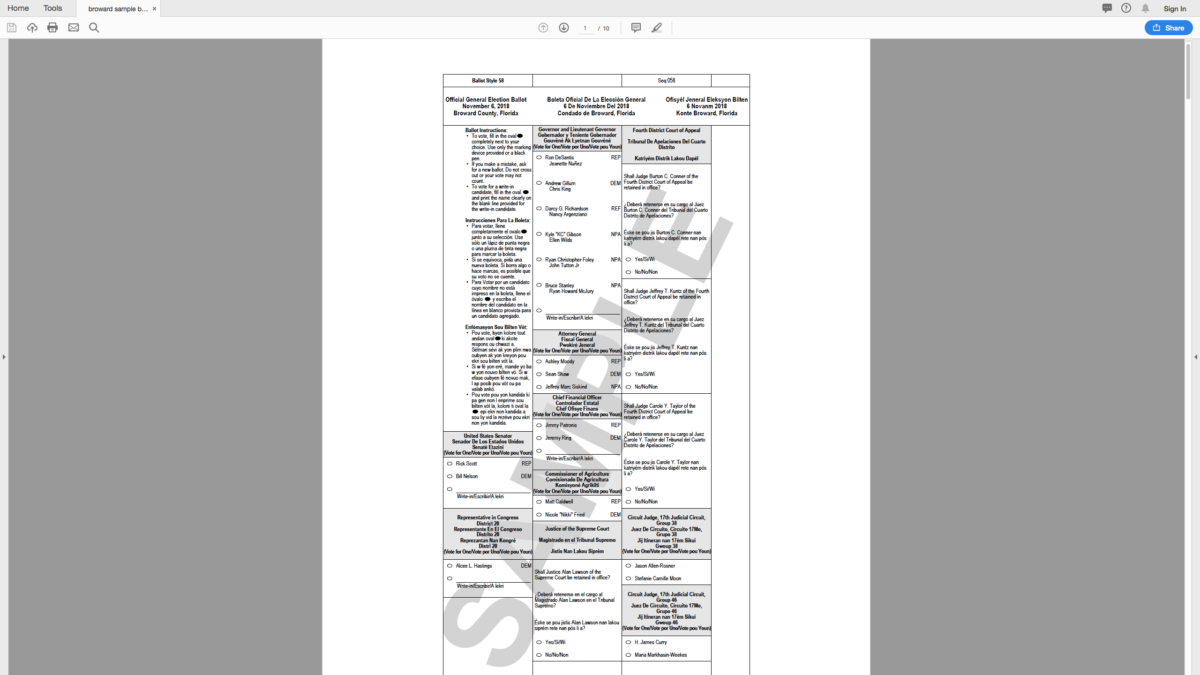
“I believe that the excessive residual votes in the Senate and congressional races are due largely to really terrible ballot design,” Garber said. She added that the Florida Fair Elections Coalition had put out recommendations in 2008, suggesting, among other things, that counties get design experts to help them with layout and conduct usability tests before the election. But she says these recommendations were ignored.
Daniel H. Wolf, the founder and CEO of Democracy Counts, the group that created a same-day election audit system, was skeptical that such a large block of voters not casting their vote could be due to ballot design. Wolf, a Harvard-educated attorney and a former statistics professor, said, “You just don’t see chunks of the population behaving like that…. This is not a trivial number.”
Missing Poll Tapes
Wolf’s opinion may have been influenced by his experience in the field in the 23rd District. His organization designed a citizens’ poll of the congressional race that centered around taking photos of poll tapes that are required by Florida law to be posted outside of every polling station at the close of polls. However, volunteers were stunned to find one polling location after another where there were either no poll tapes posted, or the poll tapes that were posted were missing the 23rd congressional race – the one between Canova and Wasserman Schultz.
Victoria Olson, a resident of Fort Lauderdale who was participating in the citizen audit through Democracy Counts, turned in data showing that of nine precincts she visited, seven poll tapes did not show results for that race. She said that she and other volunteers had a hard time finding any precincts that had posted the tapes, something she herself had posted when she worked the polls.
Susan Pynchon, the founder and executive director of the Florida Fair Elections Coalition, confirmed the existence of the statute requiring the tapes to be posted and said, “It would seem to be a clear violation if they did not post the results at each polling place.”
Wolf thinks the discrepancies may have affected other candidates in the race besides Canova. He said volunteers for Republican Joe Kaufman found that Kaufman had a strong lead on one of the tapes, but that the unofficial results from the county showed Wasserman Schultz winning in that precinct. “Joined together with all of the other data we’re producing, it begins to take on patterns and gets more persuasive,” Wolf said.
Election Experts Respond to the Data
Election experts who reviewed the data package were concerned and incredulous, with even longtime veterans of recounts and audits saying they had never seen anything like it.
Karen McKim, a coordinator at Wisconsin Election Integrity, had just finished reviewing the Dane County election audit for her state when we spoke with her by phone. She started by saying, “Looks like a royal mess!” She has conducted and coordinated six citizen audits in Dane County, Wisconsin, and has observed another half dozen.
McKim was stunned on her first viewing of the high undervote rates in precincts V012, V030, V010 and M008. She insisted, “There’s no reason the undervote rate should vary this widely across the county,” reasoning that the ballot design could explain the undervote if it was consistent across all precincts, but could in no way account for such large variation between precincts. “All those precincts were working off the same ballot design. The ballot design can’t explain that.”
Regarding the breakdown by category in the 23rd District that went missing in their later reports, she said, “It concerns me any time data disappears…. There’s some reason election officials decided to make the data disappear. And we need to understand that to know what’s going on. It’s not good.”
Discussing possible explanations, she said, “On the face of it — that’s an error.” But she acknowledged that fraud could also be designed to look like an error. “If you want to defraud someone, you make it look like a mistake.”
Election officials we consulted said that most state laws do not require jurisdictions to include information about voting method, and that there are a lot of innocent explanations for that. But Douglas Jones, a professor of computer science at the University of Iowa who served on the Election Assistance Commission’s Technical Guidelines Development Committee for four years, said via email that Broward County’s history “sets out a strong reason for being highly suspicious.”
Virginia Martin is the Democratic Election Commissioner in Columbia County, New York, where she oversees a modified hand-count audit of all or most of their ballots for every election. Martin pointed out in an email that the totals provided by Broward County do not correspond to the explanation: “A dash is said to represent between 1 and 9 votes, which it clearly does not because the totals far exceed four categories at nine votes each.” She said presenting the results this way, “strikes me as suspect.”
Regarding the undervote rate of 4.4 percent in the race between Canova and Wasserman Schultz, she said it seemed “Very odd,” and offered that the undervote rate in her congressional district is 1.3 percent.
Pynchon, the executive director of the FFEC, has reviewed dozens of elections, and spent a year investigating one set of anomalies in Sarasota, Florida. She stressed that these irregularities were not the ordinary type of small inconsistencies that frequently have to get sorted out after an election.
Security Experts Say Machine Recounts Cannot Resolve These Questions
In addition to the statewide recounts, some counties are recounting local races as well. Volusia County discovered a 240-vote discrepancy Monday night “between votes cast in the election and those tabulated in the recount,” according to the West Volusia Beacon.
Pynchon clarified that what is happening in the current Florida recount — even in the instances where it is being called a “manual count” — is not a full hand count of the votes. “They never look at all the ballots by hand.” Ballots are first fed through machines for the “machine” recount. If after the machine recount the margin of victory is within 0.25 percent, then the undervotes and overvotes are counted by hand — but only if there are enough of them to change the outcome of the election.
Garber said, “I don’t think the machine recount is very helpful. It’s not likely to get a different result if there’s some problem with the machine or the ballot … I think they should count all the ballots by hand.”
In the 2016 recount in Wisconsin, six security experts filed affidavits that the only way to accurately determine if there is fraud or error in a close contest is to examine the ballots by hand. They said that the process of running the ballots through the same machines that they were run through — or even different machines — is unlikely to discover any type of viral program or machine error in the count. Philip Stark, a professor of statistics at the University of California, Berkeley, stated in his affidavit, “The amount of error required to alter the outcome can easily be less than the error that an optical scan system makes.”
McKim says that’s exactly what happened in Racine County, Wisconsin, in 2016. “The problem was that the machine was miscounting,” she told Truthout. “It simply couldn’t read a lot of the absentee ballots. It couldn’t read them the first time and it couldn’t read them the second time…. When we came in later and did a hand count, human eyes could easily see the votes, and we found that more than 1,000 Racine County voters had been disenfranchised in the presidential election of 2016.”
Questions About Chain of Custody
Canova also retweeted video alleging provisional ballots were left behind by a truck, and that other ballots were being transported and moved between vehicles with only one person in the car.
Olson told Truthout in a phone interview that she, too, had seen poll workers transporting ballots by themselves. She said the woman she saw doing it acknowledged it was not the correct protocol, but said she was doing it anyway. Pynchon noted that at one time, there was a technical advisory in effect stating that two people should be with the ballots or memory cards of electronic voting machines at all times. Now, however, counties design their own security procedures and then submit them to the state for approval, and she says that the oversight is very lax.
A Labyrinth of Obstruction, Deception and Illegality
I have personal experience with one of the “election disasters” that Brenda Snipes presided over. In November of 2016, I filed the first of three public records requests for election materials related to the initial contest between incumbent Congresswoman Debbie Wasserman Schultz and Tim Canova in the 23rd District Democratic primary. After the primary in August 2016, I worked with a team of data analysts looking at the results of the race. There were patterns in the vote totals that concerned us. I thought that looking at the actual paper ballots in the race might help clarify whether the results were accurate, and also help determine if there was any validity to our analysis. So, I was eager to see the ballots. I also requested all of the digital ballot images, and other contextual items like poll book logs.
That was my entry into a labyrinth of obstruction, deception and ultimately criminal behavior that Broward County engaged in over the course of 18 months. The saga culminated in Snipes personally signing off on the illegal destruction of the ballots in that race, even as a court case was pending demanding that the ballots be released. Canova joined me in the public records request, and had ample opportunity to experience the county’s lack of transparency and suspicious behavior.
For example, when we requested the digital ballot images, Snipes, her attorney and Broward Registration Clerk Dolly Gibson all sent emails saying that they did not retain digital ballot images. In a December 16, 2016, email, Snipes said, “We do not capture, or use digital ballot images from the DS200.” After a year of wrangling (during which time Canova filed suit against Snipes) the county finally scheduled an inspection of the paper ballots. But on my arrival at the Broward County Board of Elections office, the county’s attorney informed me that no paper ballots were available, and that I would be shown digital ballot images instead. Then during the inspection, they claimed that they had not one but two sets of digital ballot images: one from their voting machines and a second set created by a third-party vendor. Chain of custody documents around these ballots were only partially filled out; and there was never any documentation that could prove that those digital ballot images were identical to the original paper ballots.
We never got to see the actual paper ballots in the race. Negotiations stalled repeatedly because the county refused to allow a video camera or any photographs to be taken at an inspection. The FFEC told us that photographing or videotaping ballot inspections is standard in other counties. Then during court proceedings, the county’s attorney Burnadette Norris-Weeks informed the judge that the ballots had been destroyed, a violation of both state and federal law.
Canova won a summary judgment against Snipes in May 2018, and the county was ordered to pay his legal fees. Circuit Court Judge Raag Singhal said in that ruling that the county’s defenses were “without substance in fact or law.”
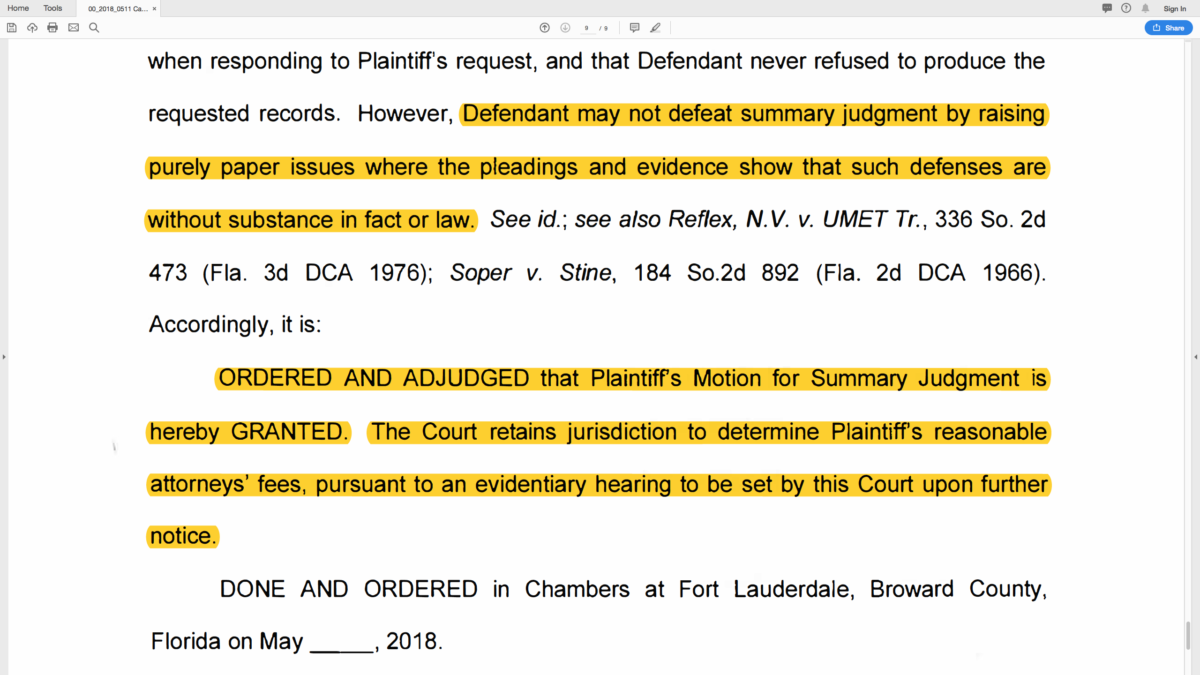
One piece of useful data that I obtained in the course of the public records requests was the county’s record of how many voters had voted in each precinct of the race. Working again with a team of data analysts, I compared the number of voters who voted with the number of cast ballots in every precinct. This is a simple, straightforward analysis to run on any election. Election officials, candidates and observers all know that at the end of a legitimate election, there needs to be an accurate reconciliation of voters to ballots. Every voter who votes needs to correspond to one and only one ballot that is counted. For example, if a voter spoils a ballot and asks for another, that has to be logged, and the spoiled ballot has to be set aside with other unusable ballots, as proof that the voter was not allowed to vote twice. In the results of Canova’s 2016 run against Wasserman Schultz, we found an over 1,000-vote discrepancy between the number of voters and the number of cast ballots. Out of 211 precincts, only 19 had the same number of voters as cast ballots. Election experts I spoke with were stunned, saying the results indicated either gross negligence or fraud.
Election Protection Advocates Descend on the State
In response to this flurry of recounts and lawsuits, election protection advocates are hunkering down in the state. John Brakey, co-founder and director of AUDIT USA, was in Broward County photographing modems in the voting machines, a security vulnerability that could allow hackers to change election results. Chris Sautter — an attorney who has filed (and won some) lawsuits in conjunction with Brakey’s group in Alabama, Virginia and Ohio — have filed a lawsuit against Secretary of State Ken Detzner and over a dozen Florida Supervisor of Elections’ officials in order to require the counties to preserve digital ballot images. Brakey and many other security advocates believe that digital ballot images are a tool that will make it easier for the public and candidates to independently verify vote counts.
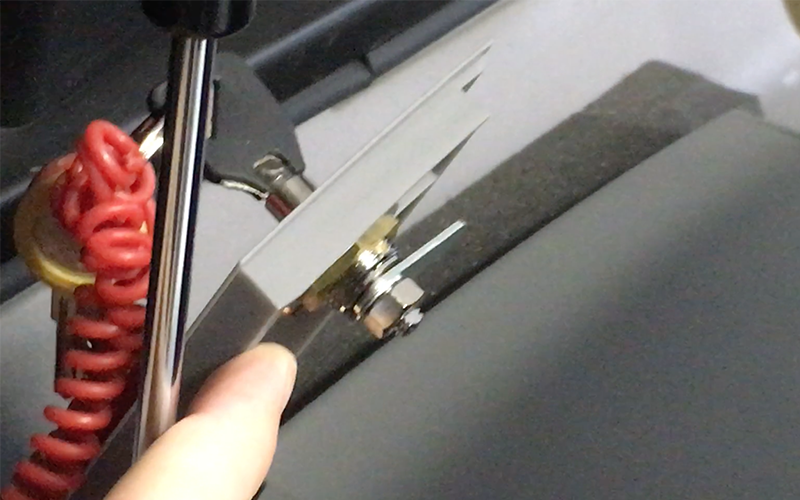
For Canova, all of this may be too little too late. In a personal text, he communicated that not only would he not run for office again, he wasn’t even sure he would ever vote again, unless a system of hand-marked paper ballots, transparently hand-counted in public, was instituted. “Short of that, I don’t think I could put myself through this again,” he said.
Part of Canova’s challenge has been that, for the most part, Democrats have chosen not to speak out when they suspect election fraud. In a September radio interview, Senator and former presidential candidate John Kerry admitted that his team suspected the 2004 presidential race in Ohio had been manipulated against them, but he said they felt it was better for the country not to contest it. Republicans are showing no such restraint, harmonizing with each other in a collective chorus about fraud and forgery. Until Democrats also help authorities and the public to identify races they consider suspect, they may continue to lose control of the narrative and experience potentially deeper losses at the ballot box.
Bennie Smith provided data analysis for this report.
Our most important fundraising appeal of the year
December is the most critical time of year for Truthout, because our nonprofit news is funded almost entirely by individual donations from readers like you. So before you navigate away, we ask that you take just a second to support Truthout with a tax-deductible donation.
This year is a little different. We are up against a far-reaching, wide-scale attack on press freedom coming from the Trump administration. 2025 was a year of frightening censorship, news industry corporate consolidation, and worsening financial conditions for progressive nonprofits across the board.
We can only resist Trump’s agenda by cultivating a strong base of support. The right-wing mediasphere is funded comfortably by billionaire owners and venture capitalist philanthropists. At Truthout, we have you.
We’ve set an ambitious target for our year-end campaign — a goal of $250,000 to keep up our fight against authoritarianism in 2026. Please take a meaningful action in this fight: make a one-time or monthly donation to Truthout before December 31. If you have the means, please dig deep.
